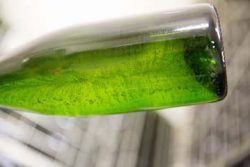
Winemaking
 MONTAIN VINEYARD
MONTAIN VINEYARD  CLAIRETTE DE DIE
CLAIRETTE DE DIE  CRÉMANT DE DIE
CRÉMANT DE DIE
 Mountain vineyard
Mountain vineyard

The Diois is a small region at the foot of the Vercors southern slope, just north of the Provence region. Vineyards are already widely cultivated there in the 1st century AD by a Gallic people called Voconces. The wine-growing area, which now enjoys a Protected Designation of Origin, plays a major economic role in the region: about 1500 hectares are spread over 31 municipalities.
It is one of the highest vineyards in France (up to 700m), subject to a contrasting climate with very sunny summers and harsh winters. Clairette de Die, Crémant de Die and Châtillon-en-Diois are definitely wines with a mountain emphasis!
 CLAIRETTE DE DIE: Ancestral method
CLAIRETTE DE DIE: Ancestral method
Muscats with small grains, harvested and sorted manually, are destemmedand pressed as early as possible.
 Filtered juices are stored in chilled tanks between 0°C and 4°C to initiate a slow fermentation in order to preserve the aromas. After several months, the semi-fermented must is bottled.
Filtered juices are stored in chilled tanks between 0°C and 4°C to initiate a slow fermentation in order to preserve the aromas. After several months, the semi-fermented must is bottled.- Still at a low temperature, the bubbles begin to take form due to « indigenous » yeasts. The sugar of the grapes is transformed into alcohol and carbon dioxide, but not fully. This gives Clairette de Die Tradition its exceptionally fruity character as well as its natural effervescence.
- This second fermentation stops when the pressure in the bottle reaches about 6 bars: the alcohol percentage is then at around 7. Another filtration in the bottles is the final step. The vinification will have lasted between 4 and 6 months.
The originality of this method lies in the fact that there is no addition of yeasts or sugar throughout the process and there is double fermentation, including one in the bottle. It requires an irreproachable quality of the grapes.
 CRÉMANT DE DIE: Traditional method
CRÉMANT DE DIE: Traditional method
Crémant de Die is a blend of three grape varieties: 75% clairette and 20% aligoté, which gives it its raw character, and about 5% muscat to keep it slightly mellow (proportions are slightly different depending on the year).
Upon harvest, the grapes are pressed whole and then undergo the traditional method:
- After a first fermentation of about 4 months in a refrigerated tank, we obtain a dry white wine, called base wine, to which we add a tirage liqueur (cane sugar and yeasts).
- This causes a second fermentation and the bubbles take form in bottles lying on slats. It must be done slowly and lasts at least 9 months.
 After this period of aging, the turning of the bottles, which was previously done on special « desks », manually and daily, consists of gradually bringing the residual deposit of dead yeasts to the neck, placing the bottle upside down. This operation takes 3 weeks.
After this period of aging, the turning of the bottles, which was previously done on special « desks », manually and daily, consists of gradually bringing the residual deposit of dead yeasts to the neck, placing the bottle upside down. This operation takes 3 weeks.- Then, the deposit is removed by a process called disgorging, by immersing the neck in a solution at -26°C. Finally, the bottle is uncapped, and the ice formed by this process is expelled by pressure. The lost volume is then offset by an addition of liqueur (grape sugar).
Unlike the clairette tradition that does not need aging, the crémant requires aging on slats from 12 to 48 months to develop its aromas.


